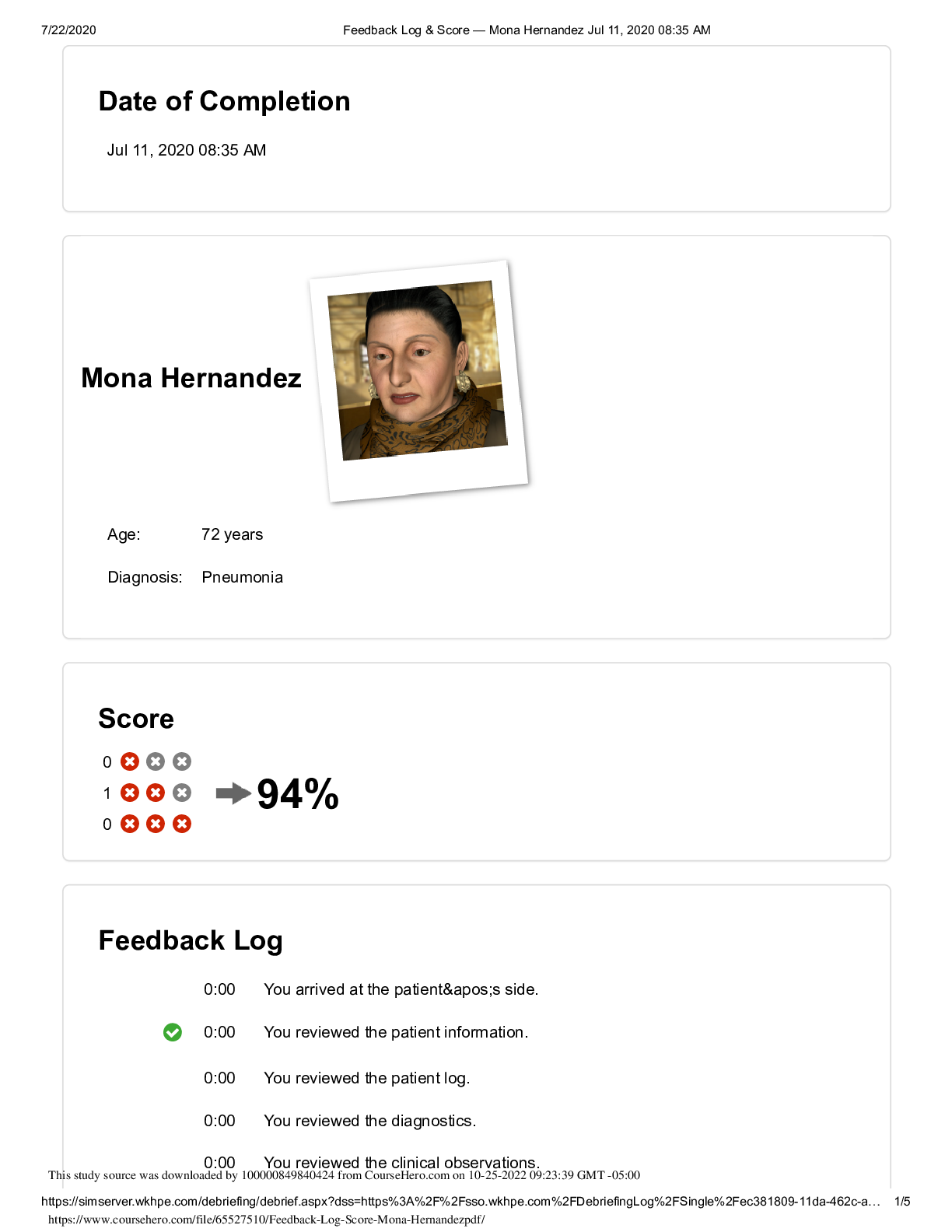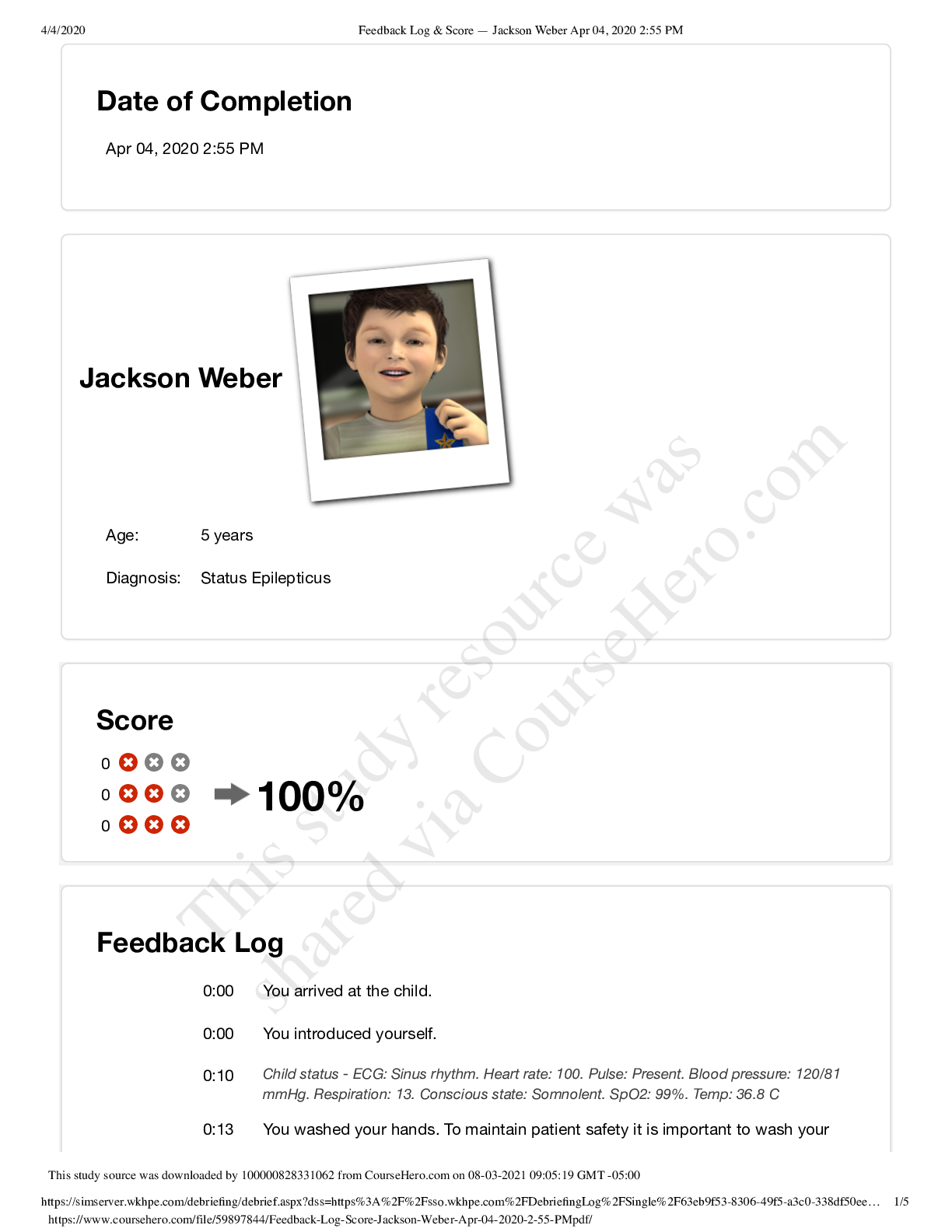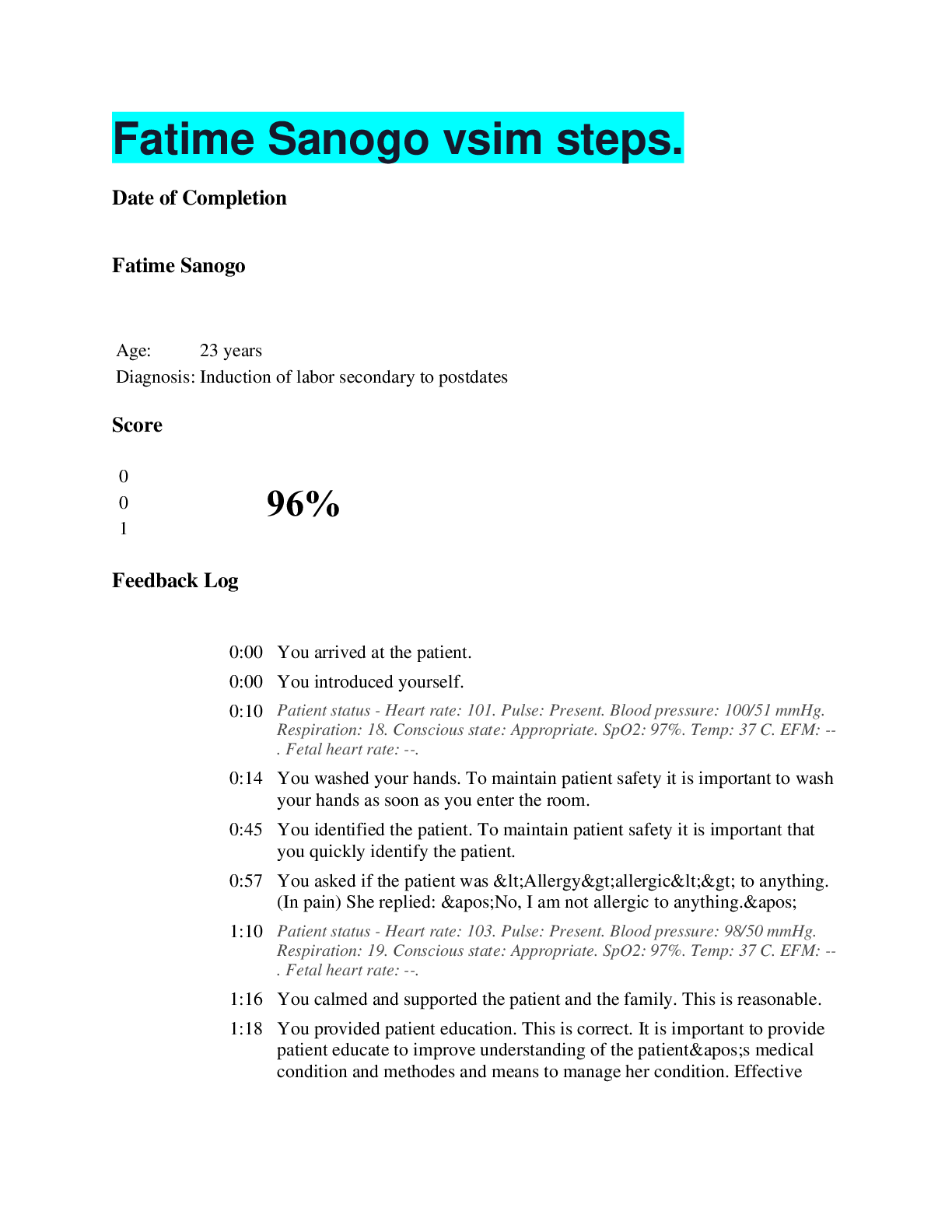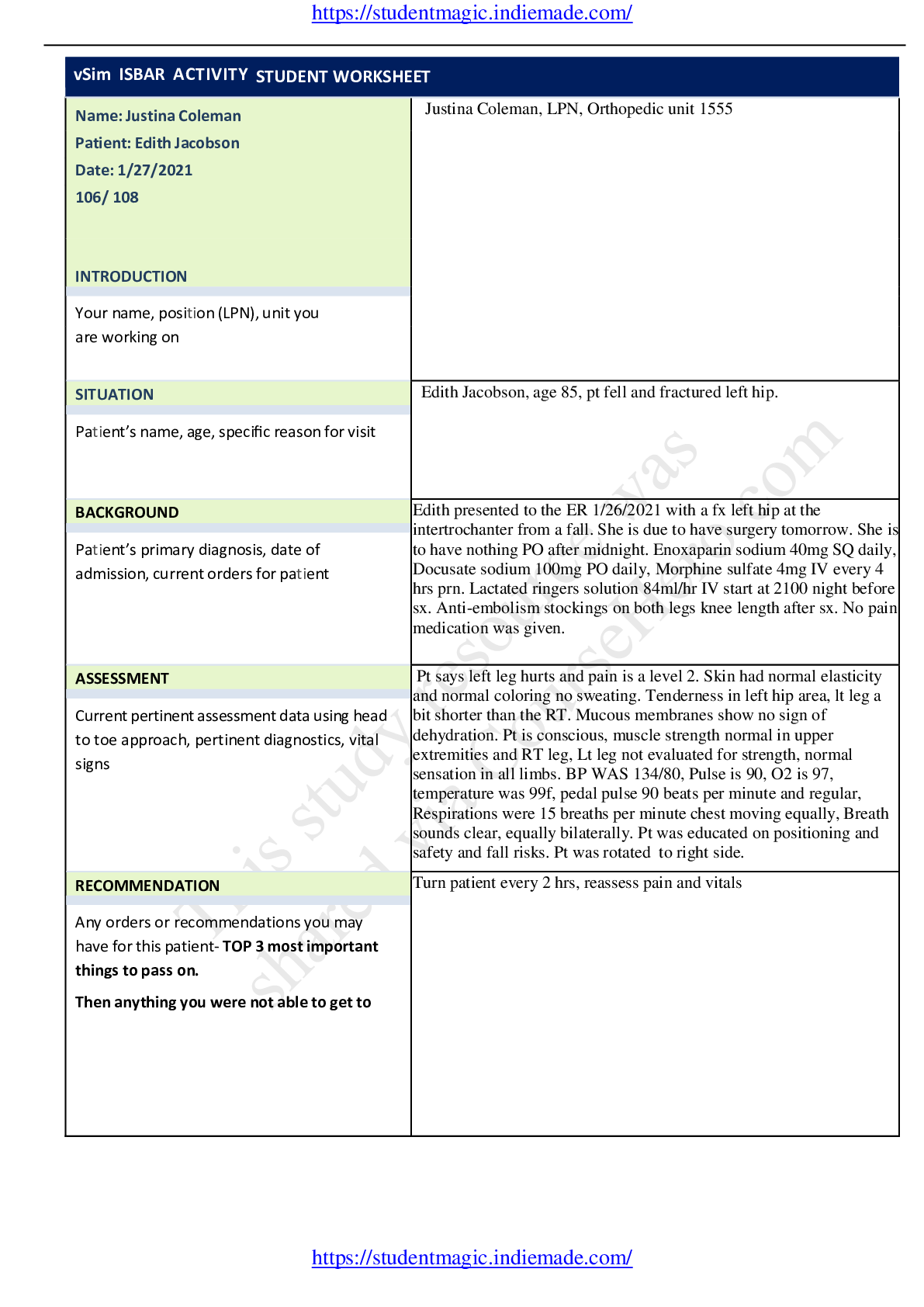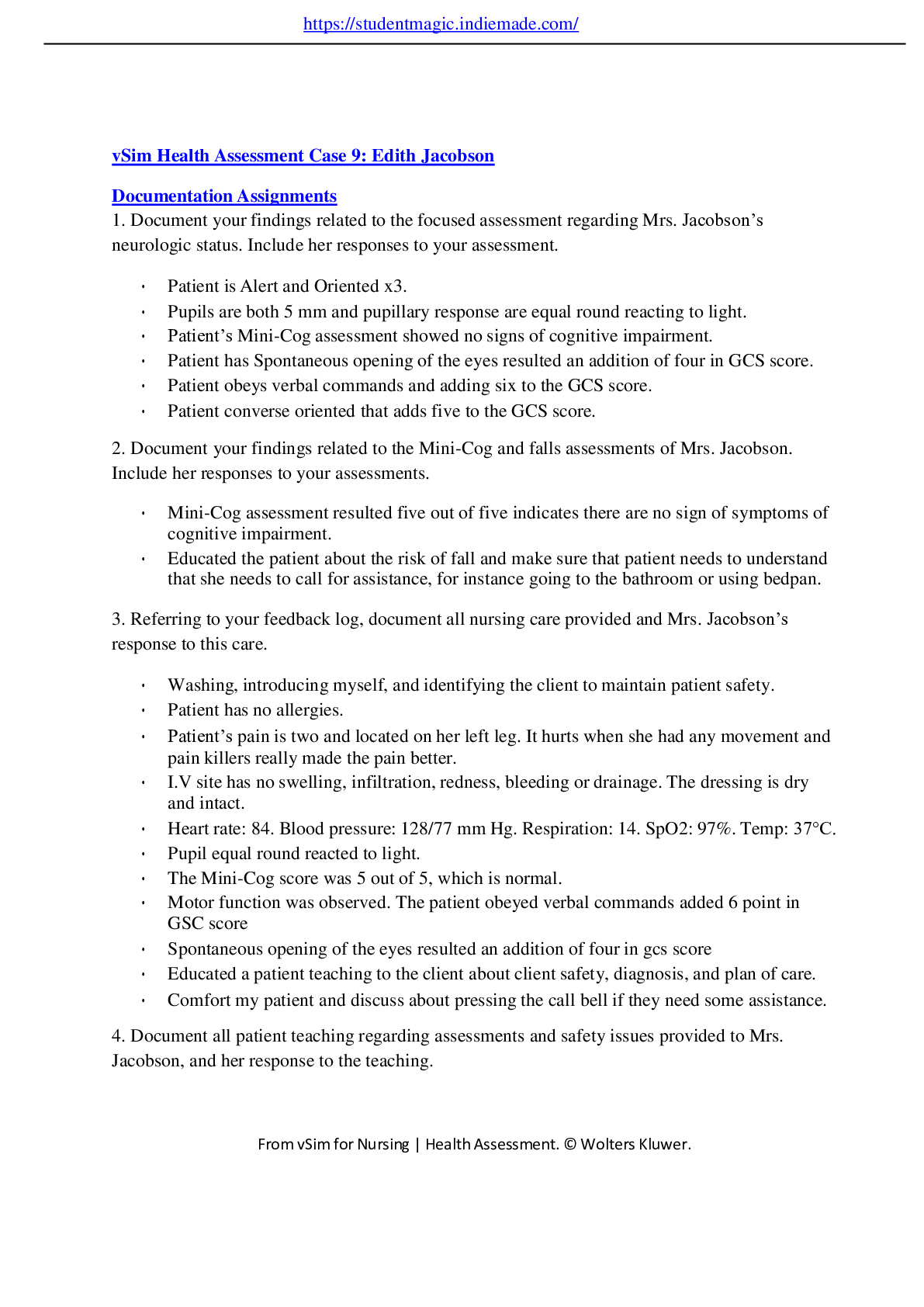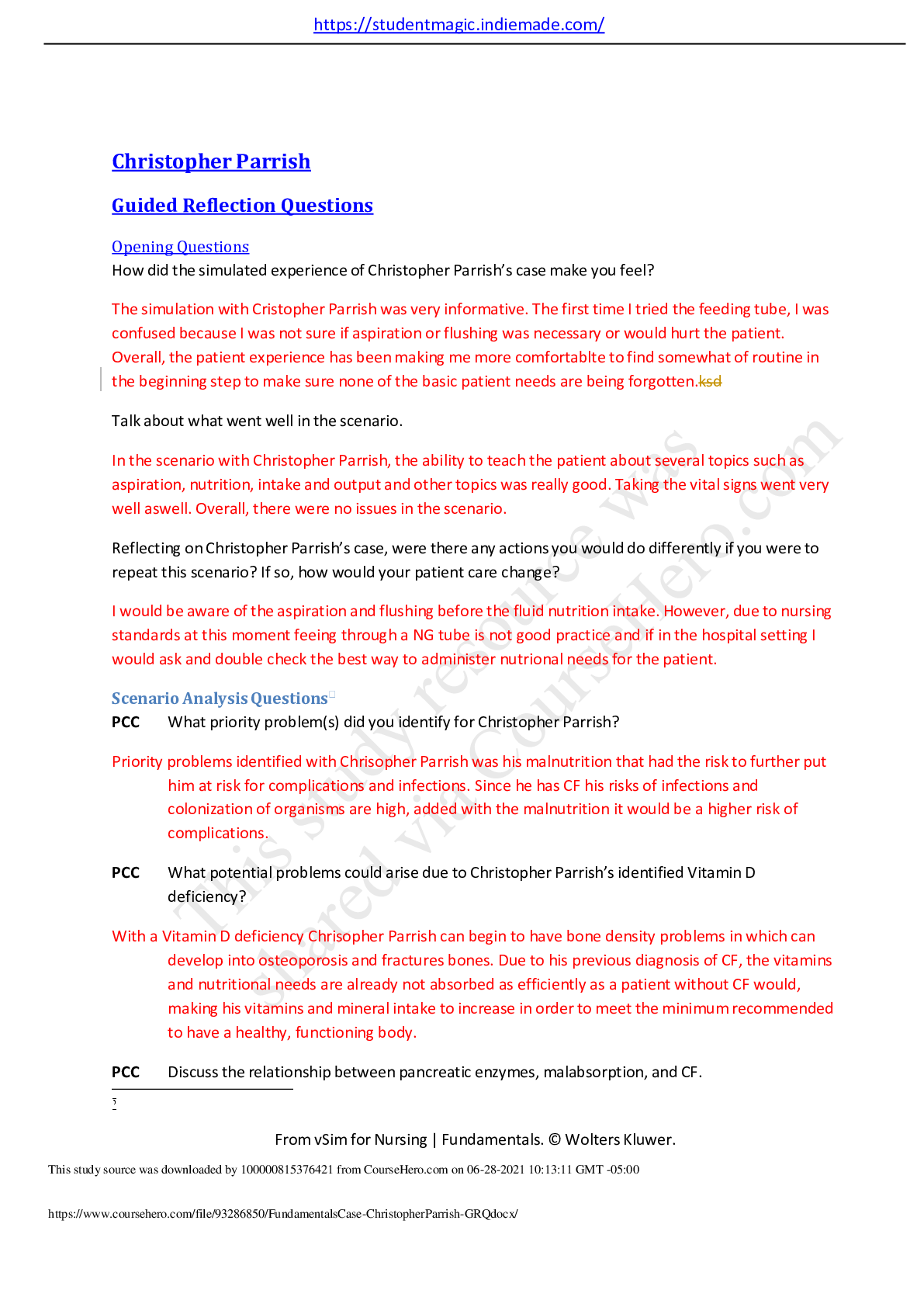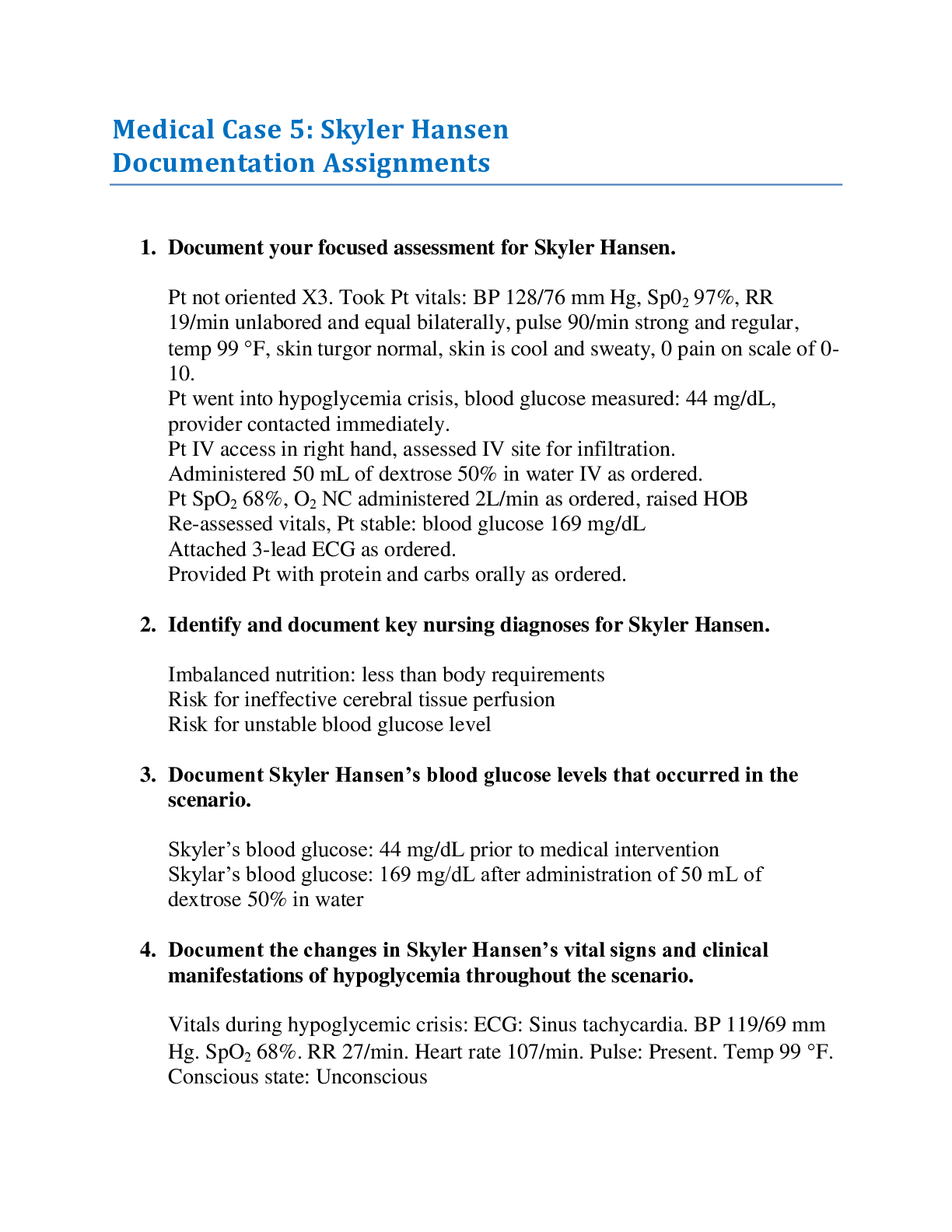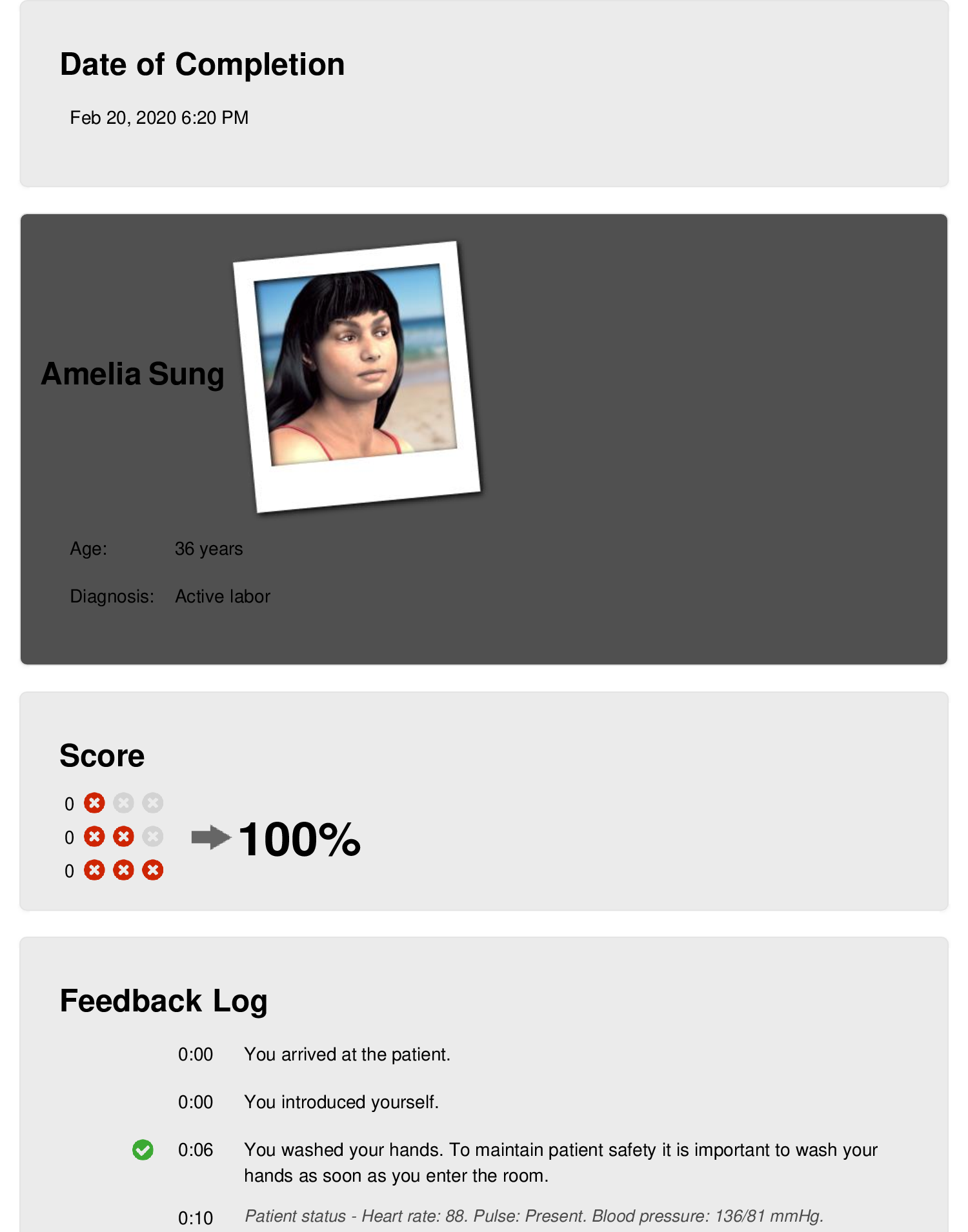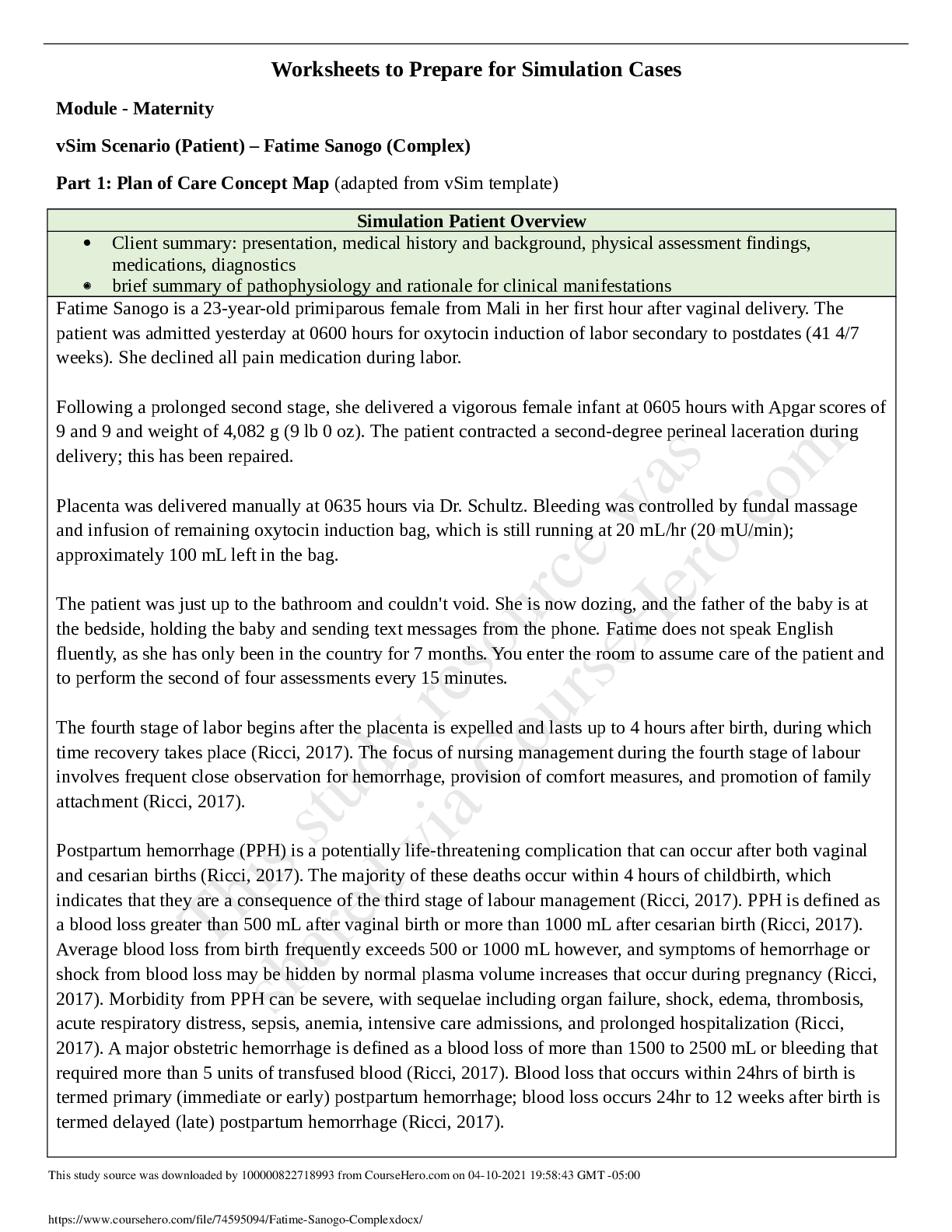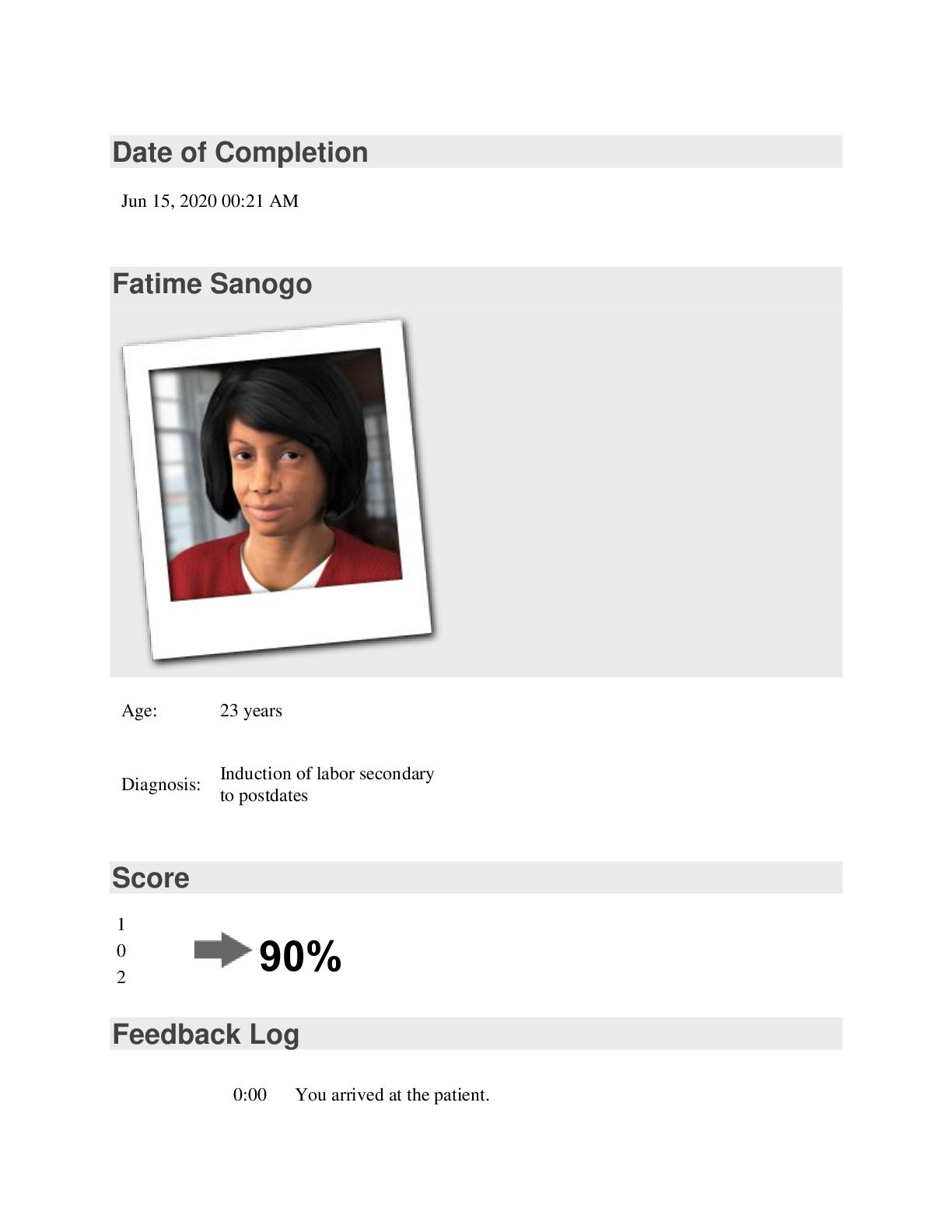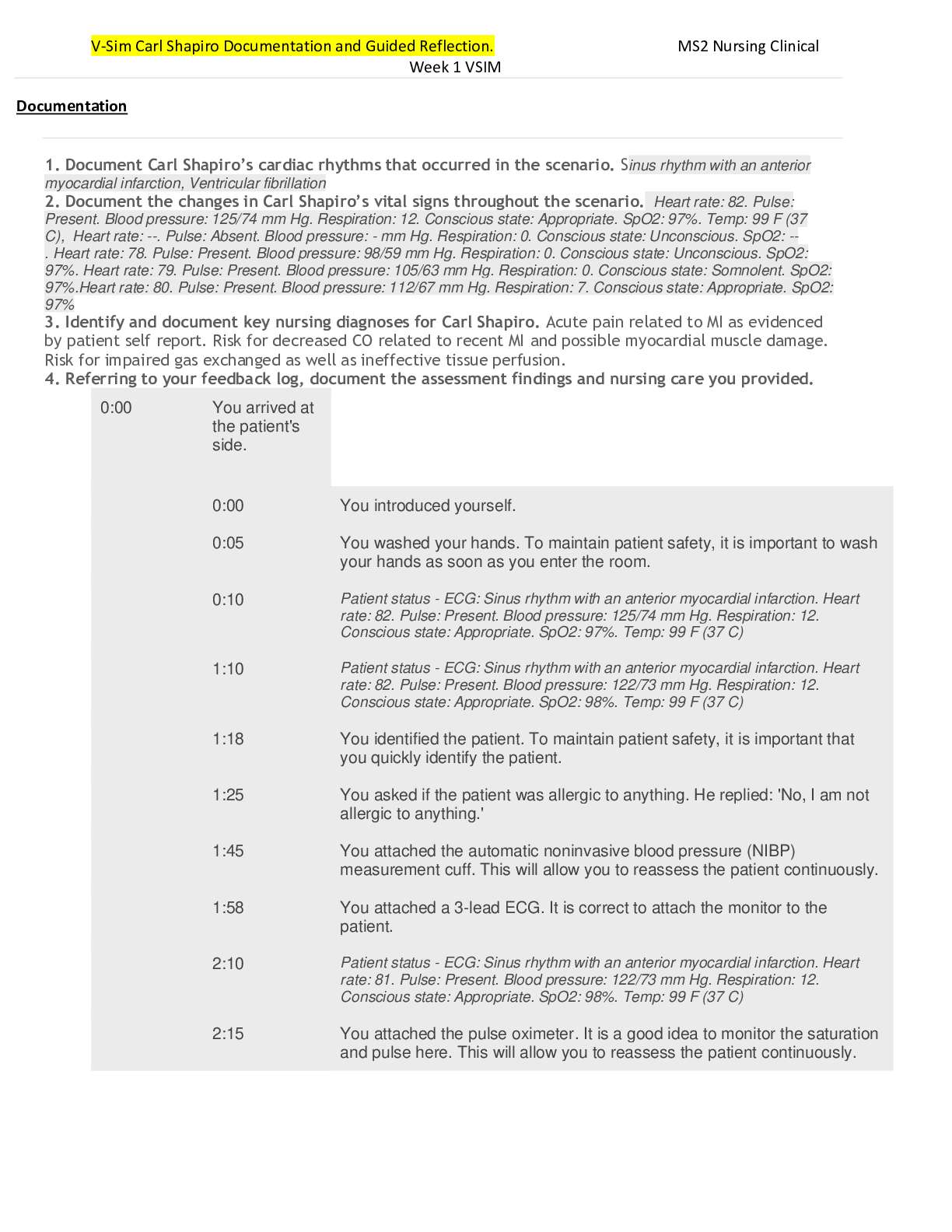*NURSING > VSIM for NURSING FUNDAMENTALS > NUR 208 Fatime Sanogo VSIM for NURSING FUNDAMENTALS Steps. Top Rated A+ (All)
NUR 208 Fatime Sanogo VSIM for NURSING FUNDAMENTALS Steps. Top Rated A+
Document Content and Description Below
Date of Completion Jul 07, 2020 10:11 AM Fatime Sanogo Age: 23 years Diagnosis: Induction of labor secondary to postdates Score 0 0 1 96% Feedback Log 0:00 You arri ved at the patient. 0:00 You introd... uced yourself. 0:10 Patient status - Heart rate: 101. Pulse: Present. Blood pressure: 100/51 mmHg. Respiration: 18. Conscious state: Appropriate. SpO2: 97%. Temp: 37 C. EFM: --. Fetal heart rate: --. 0:14 You washed your hands. To maintain patient safety it is important to wash your hands as soon as you enter the room. 0:45 You identified the patient. To maintain patient safety it is important that you quickly identify the patient. 0:57 You asked if the patient was <Allergy>allergic<> to anything. (In pain) She replied: 'No, I am not allergic to anything.' 1:10 Patient status - Heart rate: 103. Pulse: Present. Blood pressure: 98/50 mmHg. Respiration: 19. Conscious state: Appropriate. SpO2: 97%. Temp: 37 C. EFM: --. Fetal heart rate: --. 1:16 You calmed and supported the patient and the family. This is reasonable. 1:18 You provided patient education. This is correct. It is important to provide patient educate to improve understanding of the patient's medical condition and methodes and means to manage her condition. Effective communication and patient education increases patient motivation to comply. 1:30 You looked for normal breathing. She is breathing at 19 breaths per minute. The chest is moving equally. This study1so:5ur9ce waYs doouwnalottaadecdhbeyd10t0h00e08&20l3t6;3P9u76lsfreoomxCiomuresetHeerr&o.cgomt;ponu0ls4-e10o-2x0i2m1 2e2t:5e3r:.1&8 GltM;&T -g05t;:0T0 his was indicated by order. 2:10 Patient status - Heart rate: 104. Pulse: Present. Blood pressure: 99/51 mmHg. Respiration: 20. Conscious state: Appropriate. SpO2: 97%. Temp: 37 C. EFM: --. Fetal heart rate: --. 2:25 You checked the radial pulse. The pulse is strong, 105 per minute and regular. It is correct to assess the patient's vital signs. 3:01 You measured the <Bloodpressure>blood pressure<> at 98/50 mmHg. It is appropriate to monitor the patient by measuring the blood pressure. 3:10 Patient status - Heart rate: 106. Pulse: Present. Blood pressure: 98/50 mmHg. Respiration: 20. Conscious state: Appropriate. SpO2: 96%. Temp: 37 C. EFM: --. Fetal heart rate: --. 3:36 You attached the automatic noninvasive blood pressure (NIBP) measurement cuff. This will allow you to reassess the patient continuously. 4:05 You checked the <Temperature>temperature<> at the mouth. The temperature was 37 C. 4:10 Patient status - Heart rate: 107. Pulse: Present. Blood pressure: 96/49 mmHg. Respiration: 20. Conscious state: Appropriate. SpO2: 96%. Temp: 37 C. EFM: --. Fetal heart rate: --. 4:41 You checked for blood, lochia, and fluid on the bed. 4:50 You asked the patient if she had any pain. (In pain) She replied: 'Yes! Ahh...' 5:00 You asked: How bad is the pain? (In pain) She replied: 'It's pretty bad; I'd give it a 5.' 5:10 Patient status - Heart rate: 109. Pulse: Present. Blood pressure: 95/49 mmHg. Respiration: 20. Conscious state: Appropriate. SpO2: 96%. Temp: 37 C. EFM: --. Fetal heart rate: --. 5:12 You asked the patient: Where does it hurt? (In pain) She replied: 'In my belly.' 5:39 You assisted the patient into Trendelenburg position. 6:07 You assessed the patient's perineum. This was reasonable. There was minimal redness, minimal edema, no echimosis, and no discharge from the repair, and it is well approximated. A lot of blood and lochia was seen in the vaginal. She was bleeding at a moderate rate. 6:10 Patient status - Heart rate: 110. Pulse: Present. Blood pressure: 98/51 mmHg. Respiration: 20. Conscious state: Appropriate. SpO2: 95%. Temp: 37 C. EFM: --. Fetal heart rate: --. 6:50 You changed and weighed the bed pads. The increase in weight of the bed pads suggests that approximately 1230 mL of lochia was on the pads. The time since the last change of the pads suggests a bleeding rate of approximately 1980 mL/hr. 7:10 Patient status - Heart rate: 112. Pulse: Present. Blood pressure: 97/51 mmHg. Respiration: 21. Conscious state: Appropriate. SpO2: 95%. Temp: 37 C. EFM: --. Fetal heart rate: --. This study7so:2ur8ce waYs doouwnploaaldpedabtey d10t0h00e08f2u0n36d3u97s6 ofrfomuCteoruursesH. eTroh.ciosmwona0s4-r1e0a-2s0o21n2a2b:5l3e:1.8TGhMeTu-0t5e:0r0us was soft and boggy. 7:57 You assessed the bladder status. The bladder contained 300 mL of urine. 8:10 Patient status - Heart rate: 113. Pulse: Present. Blood pressure: 96/51 mmHg. Respiration: 21. Conscious state: Appropriate. SpO2: 95%. Temp: 37 C. EFM: --. Fetal heart rate: --. 8:26 You performed a straight catheterization. This was reasonable. The bladder was emptied. There was about 300 ml of urine in the bladder. 8:40 You performed fundal massage. This was indicated and the correct response to the patient's condition. The uterus did not firm up properly. 9:10 Patient status - Heart rate: 115. Pulse: Present. Blood pressure: 93/49 mmHg. Respiration: 21. Conscious state: Appropriate. SpO2: 95%. Temp: 37 C. EFM: --. Fetal heart rate: --. 9:30 You assessed the patient's IV. The site had no redness, swelling, infiltration, bleeding, or drainage. The dressing was dry and intact. This is correct. Assessing any IVs the patient has is always important. 10:10 Patient status - Heart rate: 116. Pulse: Present. Blood pressure: 94/50 mmHg. Respiration: 21. Conscious state: Appropriate. SpO2: 95%. Temp: 37 C. EFM: --. Fetal heart rate: --. 10:45 You flushed the cannula. 10:57 You administered 2 mg of butorphanol tartrate IV. It is important to use the basic rights of medication administration to ensure proper drug therapy. This was indicated by order. 11:08 You flushed the cannula. 11:10 Patient status - Heart rate: 117. Pulse: Present. Blood pressure: 93/49 mmHg. Respiration: 21. Conscious state: Appropriate. SpO2: 94%. Temp: 37 C. EFM: --. Fetal heart rate: --. 11:29 You phoned the provider in order to discuss the patient. 12:10 Patient status - Heart rate: 118. Pulse: Present. Blood pressure: 93/50 mmHg. Respiration: 21. Conscious state: Appropriate. SpO2: 94%. Temp: 37 C. EFM: --. Fetal heart rate: --. 13:09 You gave the patient 100% oxygen from a nonrebreathing mask. 13:10 Patient status - Heart rate: 120. Pulse: Present. Blood pressure: 91/49 mmHg. Respiration: 22. Conscious state: Appropriate. SpO2: 94%. Temp: 37 C. EFM: --. Fetal heart rate: --. 13:14 You turned the oxygen on. 14:09 You verified the dose with another nurse. This was reasonable. The dose was correct. 14:10 Patient status - Heart rate: 117. Pulse: Present. Blood pressure: 91/48 mmHg. Respiration: 22. Conscious state: Appropriate. SpO2: 96%. Temp: 37 C. EFM: --. Fetal heart rate: --. 15:10 Patient status - Heart rate: 117. Pulse: Present. Blood pressure: 87/47 mmHg. Respiration: 22. This study source waCs doonwsncloiaodeudsbyst1a0t0e00:0A82p03p6r3o97p6rfiraomteC. oSurpseOH2er:o.9co8m%on. 0T4-e1m0-2p0:213272:5C3:.18EGFMMT :-0-5-:0.0Fetal heart rate: --. 16:10 Patient status - Heart rate: 118. Pulse: Present. Blood pressure: 88/47 mmHg. Respiration: 22. Conscious state: Appropriate. SpO2: 99%. Temp: 37 C. EFM: --. Fetal heart rate: --. 16:12 You started a bolus of 500 mL of lactated Ringer's solution IV, given over 30 minutes. It is important to give IV fluids to bleeding patients. 16:41 You verified the dose with another nurse. This was reasonable. The dose was correct. 17:10 Patient status - Heart rate: 119. Pulse: Present. Blood pressure: 87/47 mmHg. Respiration: 22. Conscious state: Appropriate. SpO2: 99%. Temp: 37 C. EFM: --. Fetal heart rate: --. 17:42 You started infusing oxytocin postpartum (mL/hr) at 500 mL/hr. This was indicated by order. 17:58 You looked for normal breathing. She is breathing at 22 breaths per minute. The chest is moving equally. 18:10 Patient status - Heart rate: 119. Pulse: Present. Blood pressure: 88/48 mmHg. Respiration: 22. Conscious state: Appropriate. SpO2: 99%. Temp: 37 C. EFM: --. Fetal heart rate: --. 18:41 You assessed the patient's IV. The site had no redness, swelling, infiltration, bleeding, or drainage. The dressing was dry and intact. If you are in doubt, it is always a good idea to re- assess any IVs the patient has. 18:59 Patient status - Heart rate: 120. Pulse: Weak. Blood pressure: 85/46 mmHg. Respiration: 22. Conscious state: Somnolent. SpO2: 99%. Temp: 37 C. EFM: --. Fetal heart rate: --. 19:09 Patient status - Heart rate: 120. Pulse: Present. Blood pressure: 86/47 mmHg. Respiration: 22. Conscious state: Appropriate. SpO2: 99%. Temp: 37 C. EFM: --. Fetal heart rate: --. 19:11 You flushed the cannula. 19:24 You asked the patient if she had any pain. (In pain) She replied: 'Yes! Ahh...' 19:32 You asked the patient: Where does it hurt? (In pain) She replied: 'In my belly.' 19:37 Patient status - Heart rate: 120. Pulse: Weak. Blood pressure: 86/46 mmHg. Respiration: 22. Conscious state: Somnolent. SpO2: 99%. Temp: 37 C. EFM: --. Fetal heart rate: --. 19:37 You asked: How bad is the pain? (In pain) She replied: 'Not too bad; it's about a 4.' 19:47 Patient status - Heart rate: 120. Pulse: Present. Blood pressure: 87/47 mmHg. Respiration: 22. Conscious state: Appropriate. SpO2: 99%. Temp: 37 C. EFM: --. Fetal heart rate: --. 19:59 You provided patient education. 20:13 Patient status - Heart rate: 121. Pulse: Weak. Blood pressure: 86/47 mmHg. Respiration: 22. Conscious state: Somnolent. SpO2: 99%. Temp: 37 C. EFM: --. Fetal heart rate: --. 21:05 Patient status - Heart rate: 121. Pulse: Present. Blood pressure: 87/48 mmHg. Respiration: 22. Conscious state: Appropriate. SpO2: 99%. Temp: 37 C. EFM: --. Fetal heart rate: --. This study source was downloaded by 100000820363976 from CourseHero.com on 04-10-2021 22:53:18 GMT -05:00 21:15 Patient status - Heart rate: 121. Pulse: Weak. Blood pressure: 85/47 mmHg. Respiration: 22. Conscious state: Somnolent. SpO2: 99%. Temp: 37 C. EFM: --. Fetal heart rate: --. 21:39 You took a blood sample. This was not part of your orders here. 21:57 Patient status - Heart rate: 122. Pulse: Present. Blood pressure: 85/47 mmHg. Respiration: 23. Conscious state: Appropriate. SpO2: 99%. Temp: 37 C. EFM: --. Fetal heart rate: --. 22:01 You phoned the provider in order to discuss the patient. 22:07 Patient status - Heart rate: 122. Pulse: Weak. Blood pressure: 85/46 mmHg. Respiration: 23. Conscious state: Somnolent. SpO2: 99%. Temp: 37 C. EFM: --. Fetal heart rate: --. 23:07 Patient status - Heart rate: 122. Pulse: Weak. Blood pressure: 85/47 mmHg. Respiration: 23. Conscious state: Somnolent. SpO2: 99%. Temp: 37 C. EFM: --. Fetal heart rate: --. 24:06 A 800-mcg dose of misoprostol was given rectally. This was indicated by order. 24:07 Patient status - Heart rate: 123. Pulse: Weak. Blood pressure: 84/46 mmHg. Respiration: 23. Conscious state: Somnolent. SpO2: 99%. Temp: 37 C. EFM: --. Fetal heart rate: --. 24:41 You administered 5 mg of morphine IV. 24:57 You flushed the cannula. 25:03 You looked for normal breathing. She is breathing at 23 breaths per minute. The chest is moving equally. 25:07 Patient status - Heart rate: 123. Pulse: Weak. Blood pressure: 83/46 mmHg. Respiration: 23. Conscious state: Somnolent. SpO2: 99%. Temp: 37 C. EFM: --. Fetal heart rate: --. 25:27 You asked the patient if she had any medical problems. (In pain) She replied: 'Yes. I have sickle cell trait.' 25:43 You asked the patient what medication she was taking, if any. (In pain) She replied: 'No.' 25:52 You asked the patient if she was a smoker. (In pain) She replied: 'I do not smoke.' 26:07 Patient status - Heart rate: 122. Pulse: Weak. Blood pressure: 85/48 mmHg. Respiration: 23. Conscious state: Somnolent. SpO2: 99%. Temp: 37 C. EFM: --. Fetal heart rate: --. 26:11 You asked the patient how she felt. (In pain) She replied: 'Not good, it's actually worse' 26:23 You asked: How bad is the pain? (In pain) She replied: 'Not too bad; it's about a 3.' 26:33 Patient status - Heart rate: 122. Pulse: Present. Blood pressure: 84/49 mmHg. Respiration: 23. Conscious state: Appropriate. SpO2: 99%. Temp: 37 C. EFM: --. Fetal heart rate: --. This study source was downloaded by 100000820363976 from CourseHero.com on 04-10-2021 22:53:18 GMT -05:00 26:41 You provided patient education. 27:09 You calmed and supported the patient and the family. 27:10 You ended the scenario by returning to the nurse's station. This was reasonable. The patient's prolonged second stage, long third stage, and manual removal of the placenta put her at high risk for hemorrhage. In this situation, the nurse needs to address the most likely cause of the boggy uterus: retained placental fragments. Therefore, the nurse should prioritize encouraging uterine contractions. After that, uterotonics are the next priority and should be used in a stepwise fashion, moving on to the next medicine if the previous one fails. Constant assessment of uterotonic effect is critical in deciding whether the medicine has had an effect. [newline][newline]Although catheterization, increased oxytocin infusion, and administration of misoprostol are adequate in this situation, it is important to plan for the next steps in case the patient deteriorates further. This includes calling the provider for help, getting additional medications ready for administration, and anticipating infusion of blood products.[newline] [newline]The beads and/or amulets worn by the patient are often worn around the female waist in the Mande and other West African cultures as a way to express both femininity and fertility, and for specific spiritual and/or medicinal purposes. For example, some beads or amulets may be intended to ward off spirits and to protect the infant's and mother's health during pregnancy and delivery. You got 96% [Show More]
Last updated: 1 year ago
Preview 1 out of 12 pages

Reviews( 0 )
Document information
Connected school, study & course
About the document
Uploaded On
Sep 19, 2021
Number of pages
12
Written in
Additional information
This document has been written for:
Uploaded
Sep 19, 2021
Downloads
0
Views
62


